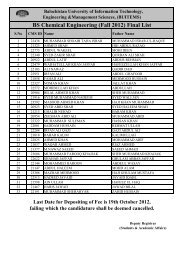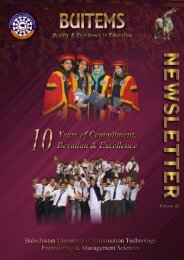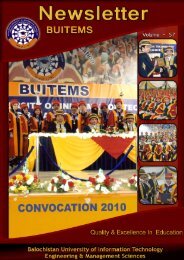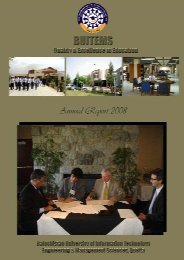BUITEMS
Research Journal - buitems
Research Journal - buitems
- No tags were found...
Create successful ePaper yourself
Turn your PDF publications into a flip-book with our unique Google optimized e-Paper software.
<strong>BUITEMS</strong><br />
Quality & Excellence in Education<br />
Handshaking vs. Instant Broadcast in VANET Safety Message Routing<br />
vehicles. Urban Multi-hop Broadcast (UMB)<br />
(Korkmaz and Ekici, 2004) BROADCOMM<br />
(Durresi et al., 2005) and Smart Broadcast<br />
(SB) (Fasolo et al., 2006) are among<br />
prominent works using broadcast technique.<br />
Most broadcast methods adopt the<br />
conventional 802.11 like RTS/CTS<br />
handshake before transmitting the actual<br />
safety message. RTB/CTB (request to<br />
broadcast/clear to broadcast) handshake in<br />
VANETs (substitute for RTS/CTS handshake<br />
in 802.11) is used to mitigate the hidden node<br />
problem. Unlike 802.11, here the safety<br />
message initiator exchanges RTB/CTB with<br />
only one of the recipients among its<br />
neighbors. However, note that due to the<br />
small size of VANET safety message payload<br />
length of 100 bytes on average(Xu et al.,<br />
2004), each safety message transmission<br />
occupies the radio channel for a very brief<br />
amount of time as opposed to a data stream.<br />
Consequently, in case of message<br />
transmission without RTB/CTB handshake,<br />
the likelihood of message collision due to<br />
hidden node is virtually equal to that with the<br />
use of RTB/CTB exchange. Also importantly,<br />
since vehicular topology has mostly extended<br />
distribution of vehicles and multihop<br />
transmission, the so called gagged terminal<br />
problem and masked terminal problem are<br />
acute in VANET scenario. Moreover, the<br />
extended distribution of vehicles also has<br />
frequent instances of hidden terminals<br />
outside the transmission range of receivers<br />
i.e. the CTB message from receivers is<br />
unheard by those hidden terminals, thus<br />
causing handshaking ineffective. Several<br />
works in the literature evaluate the efficiency<br />
of handshaking mechanism in infrastructure<br />
based 802.11 networks (Sobrinho, 2005) and<br />
general ad hoc networks (Xu et al., 2002).<br />
However, to the best of our knowledge, there<br />
does not exist any work in hitherto literature<br />
that concerns the evaluation of handshaking<br />
mechanism with regards to VANETs.<br />
In this paper, the efficiency of safety message<br />
dissemination using handshake based<br />
broadcast in VANETs is evaluated. Instant<br />
broadcast, a simplified version of Smart<br />
Broadcast technique, is recommended where<br />
safety message is propagated without using<br />
handshaking mechanism and related control<br />
packets. Analytical model based on Markov<br />
chain modeling is also developed for<br />
message propagation delaying instant<br />
broadcast. Thorough evaluation and<br />
comparisons performed in ns-3 simulator<br />
show that lower propagation delay can be<br />
guaranteed by avoiding handshaking<br />
mechanism and at the same ensuring<br />
reliability of reception by all the relevant<br />
nodes. The main contributions of this work<br />
are: evaluating the effectiveness of<br />
handshake mechanism in VANETs for the<br />
first time, improved end to end propagation<br />
speed by 100% each hop through avoiding<br />
handshake, theoretical analysis of delay for<br />
the instant broadcast method which can be<br />
easily extended for delay in any broadcast<br />
method in VANETs, and profound simulation<br />
results by modeling the communication<br />
architecture in ns-3 simulator.<br />
Handshake Based Routing Techniques in<br />
Vanets<br />
Several handshake based routing techniques<br />
have been proposed for VANETs. However,<br />
safety message dissemination in VANETs<br />
imposes strict constraints of minimized<br />
propagation delay and guaranteed delivery<br />
to all relevant vehicles. Therefore, we will<br />
focus our discussion to two solutions that<br />
comply best with these requirements (Li and<br />
Wang, 2007; Yang and Chou, 2008). In the<br />
following, we detail the functionality of Urban<br />
Multi-hop Broadcast and Smart Broadcast<br />
routing solutions.<br />
Urban Multi-hop Broadcast (UMB)<br />
In UMB protocol, node that is furthest away<br />
from the sender is selected for the message<br />
relay and is engaged in RTB/CTB<br />
handshake. To select the relay node, the<br />
coverage area of the sender is divided into<br />
equal size sectors in the direction of<br />
dissemination of message. The relay node is<br />
selected in the furthest sector. The sender<br />
node broadcasts a control packet called<br />
Request to Broadcast (RTB) which contains<br />
the geographical location of the source and<br />
sector size. When the nodes in the direction<br />
of dissemination receive this RTB packet,<br />
they compute their distance to the source.<br />
39
















